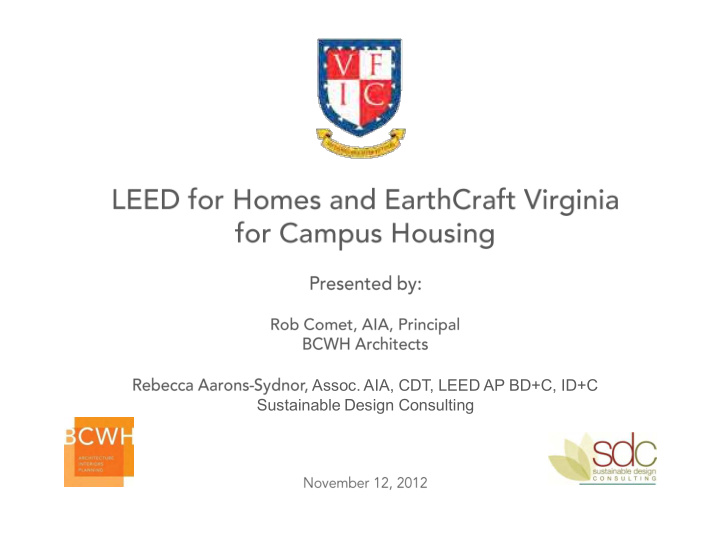



Assoc. AIA, CDT, LEED AP BD+C, ID+C Sustainable Design Consulting
BCWH Architects • 30 Person firm located in Richmond, VA • Educational projects have been our focus for over 26 years • Architecture and Interior Design Educational Planning and Programming • Higher Education experience: Campus Housing Sports Facilities Dining Halls Interior Renovations Learning Environments
Introduction to Sustainable Design Consulting • Offices in DC and Central VA • Principal was first LEED Fellow in VA • Consulted on over 200 LEED-related projects • What we do: o Green building project management o Drawing and specification review o LEED advisory/ coaching o Lectures, workshops, and trainings o Design guidance and research o Owner Policies and Procedures
In 1993, Rick Fedrizzi, David Gottfried and Mike Italiano established the U.S. Green Building Council. Their mission: to promote sustainability in the building and construction industry.
LEED 2009
LEED NC and Residential Projects
LEED NC with Residential Compliance Path
Challenges with LEED NC and Lower Scale Multi-family Projects
Code Requirements for Low-Rise vs Mid/High Rise
Evolution of LEED from Multi-Family to LEED for Homes
Reference Standards Indoor Water Use: Indoor Water Use: EPA WATER SENSE ENERGY POLICY ACT 1992 and IPCC Energy and Atmosphere: Energy and Atmosphere: ENERGY STAR HOMES ASHRAE 90.1 IEQ – Outdoor Air Ventilation: IEQ – Outdoor Air Ventilation: ASHRAE 62.2 ASHRAE 62.1
- More Streamlined - Includes On-Site Testing by a LEED Homes Provider - No Commissioning - Less Costly - Differentiates Residential Projects from Larger Commercial Projects - Creates Uniformity of Certification Amongst Residential Projects
LEED for Homes Current and Future Projects
Residential Applications
LEED for Homes Certification Requirements 1. A building cannot be partially certified. Single units in multi-family buildings cannot participate in LEED for Homes unless the entire building is registered to participate. Stacked attached homes, such as condominium flats, are considered to be multi-family buildings. 2. Every unit within a multi-family building must earn the same certification level (e.g. Silver, Gold). 3. Separate buildings must be certified separately. Multiple buildings in a complex, or single- family homes in a subdivision, may be certified separately, but it’s not a requirement that all the buildings or homes be certified or that they meet the same certification level. If multiple buildings are planning to certify through the program, each participating building must be registered with USGBC. Single-family side-by-side attached homes, such as row houses, are considered to be separate buildings.
The Future of Homes and Mid-Rise USGBC desires to increase mid-rise to 10 or 12 stories which may coincide with the release of LEED 2014
Certification Process for Homes how it differs from LEED-NC
LEED for Homes Provider - Certify the project with GBCI oversight/auditing - Utilize a Green Rater for on-site testing and inspections
No LEED Online Documentation package prepared by the provider includes: Material Information from the Contractor Information from the Design Team On-site Observation and Test Results
Submission Requirements - One Submission at the end of the Project - LEED for Homes Workbook
No Commissioning
Credits for LEED for Homes How they differ from LEED-NC
Size of Residence Impacts Number of Credits
ID Credits Solar Orientation Design Charrette
- 125 points and many more prerequisites - More Prescriptive than Performance Based - Minimum number of points per category in addition to Prerequisites - Can Achieve Credits for: Durability Limiting Turf Grass Efficient Framing Techniques Combustion Venting
Earthcraft Brief History, Purpose, Earthcraft VA
Southeast Climate Factor
Earthcraft Evolves
Earthcraft Credits - Prescriptive / Some Performance Based Credits - Focus on Proper Insulation, Sealing and Indoor Air Quality - Credits Related to Moisture Control
Technical Advisors and On-site Inspectors - Guide Projects through the Process and Certification - Administer On-site Tests
Pros and Cons Based on System Criteria, Certification Related Costs, Marketability - LEED-H has more name recognition nationally - Earthcraft is written for our climate - Earthcraft may be simpler to apply for an uninitiated team/ owner because it’s more prescriptive - Both employ on-site visits, inspections, tests - Both are less expensive than LEED-NC overall, and Earthcraft-related certification fees (professional fees plus Earthcraft VA imposed fees) are often lower than LEED-H - LEED is probably more advanced, though Earthcraft is beyond code in many ways too - Teams and owners already familiar with LEED would have less of a learning curve moving to LEED-H vs Earthcraft - Since the systems have some differing criteria, knowing requirements of each would create a better building, but only 1 certification is needed, though both can be done.
Example Credits - Sealant at Bottom Plate to Floor or Foundaton - Sealed Penetrations in Ceiling - Fully Taped and Sealed Housewrap - Energy Star Bathroom Fans - Urea-formaldehyde Free Insulation / Subflooring - Tree Preservation
University of Richmond South Campus Apartments
Randolph-Macon College Birdsong Senior Residence Hall
Thank-you.
Recommend
More recommend